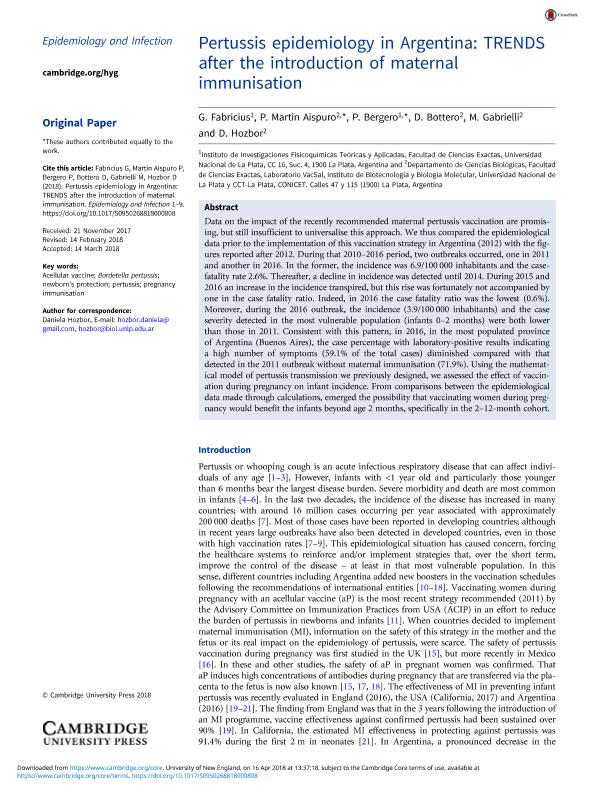Mostrar el registro sencillo del ítem
dc.contributor.author
Fabricius, Gabriel

dc.contributor.author
Martin Aispuro, Pablo

dc.contributor.author
Bergero, Paula Elena

dc.contributor.author
Bottero, Daniela

dc.contributor.author
Gabrielli, Magali

dc.contributor.author
Hozbor, Daniela Flavia

dc.date.available
2020-02-07T20:15:21Z
dc.date.issued
2018-05
dc.identifier.citation
Fabricius, Gabriel; Martin Aispuro, Pablo; Bergero, Paula Elena; Bottero, Daniela; Gabrielli, Magali; et al.; Pertussis epidemiology in Argentina: TRENDS after the introduction of maternal immunisation; Cambridge University Press; Epidemiology and Infection; 146; 7; 5-2018; 858-866
dc.identifier.issn
0950-2688
dc.identifier.uri
http://hdl.handle.net/11336/96927
dc.description.abstract
Data on the impact of the recently recommended maternal pertussis vaccination are promising, but still insufficient to universalise this approach. We thus compared the epidemiological data prior to the implementation of this vaccination strategy in Argentina (2012) with the figures reported after 2012. During that 2010-2016 period, two outbreaks occurred, one in 2011 and another in 2016. In the former, the incidence was 6.9/100 000 inhabitants and the case-fatality rate 2.6%. Thereafter, a decline in incidence was detected until 2014. During 2015 and 2016 an increase in the incidence transpired, but this rise was fortunately not accompanied by one in the case fatality ratio. Indeed, in 2016 the case fatality ratio was the lowest (0.6%). Moreover, during the 2016 outbreak, the incidence (3.9/100 000 inhabitants) and the case severity detected in the most vulnerable population (infants 0-2 months) were both lower than those in 2011. Consistent with this pattern, in 2016, in the most populated province of Argentina (Buenos Aires), the case percentage with laboratory-positive results indicating a high number of symptoms (59.1% of the total cases) diminished compared with that detected in the 2011 outbreak without maternal immunisation (71.9%). Using the mathematical model of pertussis transmission we previously designed, we assessed the effect of vaccination during pregnancy on infant incidence. From comparisons between the epidemiological data made through calculations, emerged the possibility that vaccinating women during pregnancy would benefit the infants beyond age 2 months, specifically in the 2-12-month cohort.
dc.format
application/pdf
dc.language.iso
eng
dc.publisher
Cambridge University Press

dc.rights
info:eu-repo/semantics/openAccess
dc.rights.uri
https://creativecommons.org/licenses/by-nc-sa/2.5/ar/
dc.subject
ACELLULAR VACCINE
dc.subject
BORDETELLA PERTUSSIS
dc.subject
NEWBORN'S PROTECTION
dc.subject
PERTUSSIS
dc.subject
PREGNANCY IMMUNISATION
dc.subject.classification
Epidemiología

dc.subject.classification
Ciencias de la Salud

dc.subject.classification
CIENCIAS MÉDICAS Y DE LA SALUD

dc.title
Pertussis epidemiology in Argentina: TRENDS after the introduction of maternal immunisation
dc.type
info:eu-repo/semantics/article
dc.type
info:ar-repo/semantics/artículo
dc.type
info:eu-repo/semantics/publishedVersion
dc.date.updated
2019-10-04T13:41:24Z
dc.journal.volume
146
dc.journal.number
7
dc.journal.pagination
858-866
dc.journal.pais
Reino Unido

dc.journal.ciudad
Cambridge
dc.description.fil
Fil: Fabricius, Gabriel. Consejo Nacional de Investigaciones Científicas y Técnicas. Centro Científico Tecnológico Conicet - La Plata. Instituto de Investigaciones Fisicoquímicas Teóricas y Aplicadas. Universidad Nacional de La Plata. Facultad de Ciencias Exactas. Instituto de Investigaciones Fisicoquímicas Teóricas y Aplicadas; Argentina
dc.description.fil
Fil: Martin Aispuro, Pablo. Consejo Nacional de Investigaciones Científicas y Técnicas. Centro Científico Tecnológico Conicet - La Plata. Instituto de Biotecnología y Biología Molecular. Universidad Nacional de La Plata. Facultad de Ciencias Exactas. Instituto de Biotecnología y Biología Molecular; Argentina
dc.description.fil
Fil: Bergero, Paula Elena. Consejo Nacional de Investigaciones Científicas y Técnicas. Centro Científico Tecnológico Conicet - La Plata. Instituto de Investigaciones Fisicoquímicas Teóricas y Aplicadas. Universidad Nacional de La Plata. Facultad de Ciencias Exactas. Instituto de Investigaciones Fisicoquímicas Teóricas y Aplicadas; Argentina
dc.description.fil
Fil: Bottero, Daniela. Consejo Nacional de Investigaciones Científicas y Técnicas. Centro Científico Tecnológico Conicet - La Plata. Instituto de Biotecnología y Biología Molecular. Universidad Nacional de La Plata. Facultad de Ciencias Exactas. Instituto de Biotecnología y Biología Molecular; Argentina
dc.description.fil
Fil: Gabrielli, Magali. Consejo Nacional de Investigaciones Científicas y Técnicas. Centro Científico Tecnológico Conicet - La Plata. Instituto de Biotecnología y Biología Molecular. Universidad Nacional de La Plata. Facultad de Ciencias Exactas. Instituto de Biotecnología y Biología Molecular; Argentina
dc.description.fil
Fil: Hozbor, Daniela Flavia. Consejo Nacional de Investigaciones Científicas y Técnicas. Centro Científico Tecnológico Conicet - La Plata. Instituto de Biotecnología y Biología Molecular. Universidad Nacional de La Plata. Facultad de Ciencias Exactas. Instituto de Biotecnología y Biología Molecular; Argentina
dc.journal.title
Epidemiology and Infection

dc.relation.alternativeid
info:eu-repo/semantics/altIdentifier/doi/http://dx.doi.org/10.1017/S0950268818000808
dc.relation.alternativeid
info:eu-repo/semantics/altIdentifier/url/https://www.cambridge.org/core/journals/epidemiology-and-infection/article/pertussis-epidemiology-in-argentina-trends-after-the-introduction-of-maternal-immunisation/34731F025D206D85064381999A06C86B
Archivos asociados
